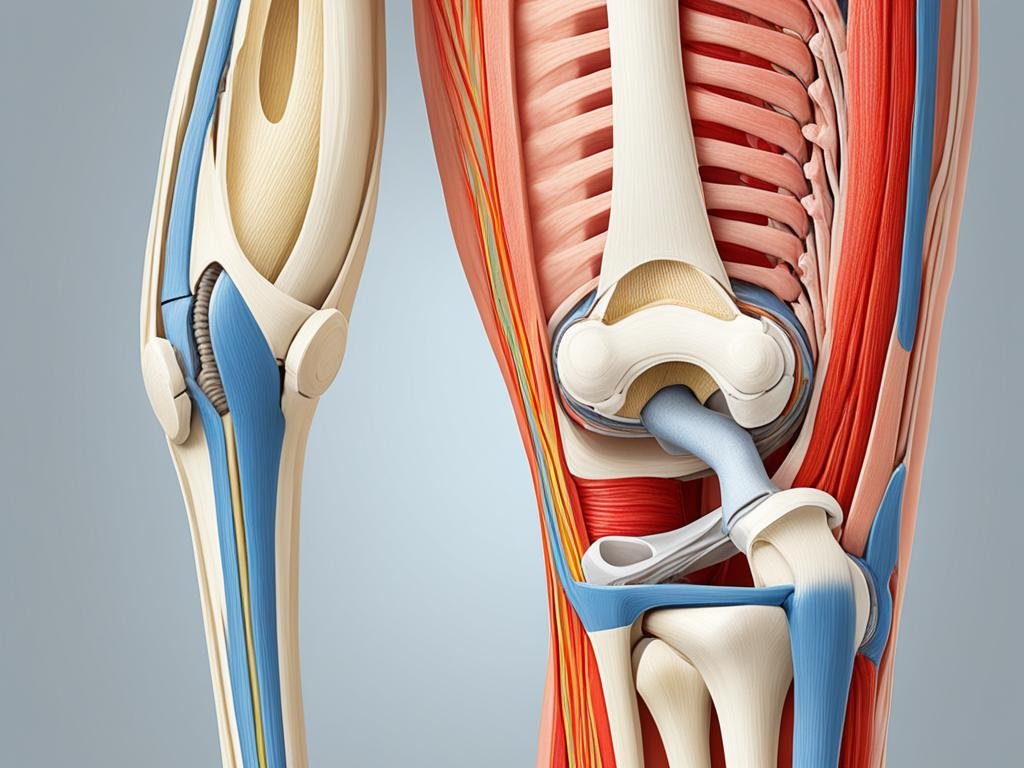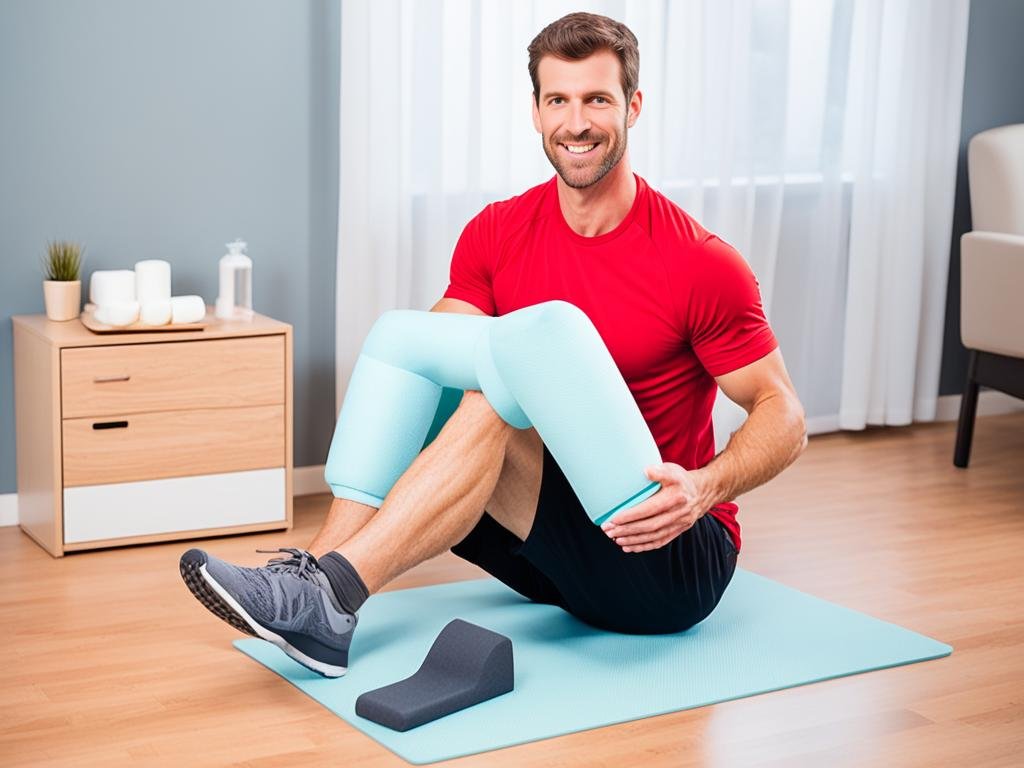Welcome to this article on Pes Anserine bursitis, a condition that can cause discomfort and impact your daily life. Whether you are a fitness enthusiast or someone who leads an active lifestyle, it is essential to understand the causes of Pes Anserine bursitis and the available relief and management strategies to alleviate symptoms and prevent future outbreaks.
At some point, you may have experienced knee pain or discomfort that interferes with movement. Orbital bursitis is a common condition affecting the inside of the knee, specifically the orbital bursa, a small fluid-filled sac located between the tendon and the bone. When this bursa becomes inflamed, bursitis occurs.
There are many factors that can contribute to the development of subacromial bursitis. Overuse, repetitive fatigue, and biomechanical problems can stress the bursa and surrounding structures. Muscle weakness and stiffness in the medial thigh and hamstring also affect the knee joint and increase the risk of bursitis.
This article explores in detail the causes of popliteal bursitis, identifies its symptoms, and discusses professional diagnosis. We will also delve into best practices for managing pisiform bursitis, including nonpharmacologic approaches and pharmacotherapy options. Additionally, we will focus on the role of physical therapy and provide specific exercises and stretches for relief.
Key Takeaways:
- Understanding pes anserine bursitis is crucial for managing and preventing the condition.
- Causes of pes anserine bursitis include overuse, repetitive strain, and muscular weaknesses.
- Seeking professional diagnosis is important for accurate treatment.
- Management strategies for pes anserine bursitis include rest, ice, compression, elevation, and physical therapy.
- Specific exercises and stretches can help alleviate symptoms and promote long-term relief.
What is Pes Anserine Bursitis?
Orbital bursitis refers to inflammation of the orbital bursa, a small fluid-filled sac located just below the knee joint on the inside of the knee. Inflammation and swelling of the bursa often occur due to overuse or repetitive motion that puts stress on the knee joint.
The popliteal bursa plays an important role in joint health by acting as a cushion and reducing friction between tendons, muscles, and bones. However, when the bursa becomes inflamed, it causes discomfort and pain on the inside of the knee, limiting mobility and activities of daily living.
To help visualize the location of the anserine bursa in the knee, refer to the image below:
Please note that this image is for illustrative purposes only and may not reflect the exact appearance of anserine bursitis of the knee.
Understanding the role of the bursa in joint health is critical to understanding the effects of popliteal bursitis. Bursae act as protective cushions, reducing friction between bones, tendons, and muscles. When these bursae become inflamed, they cause pain, swelling, and discomfort in the affected area..
Identifying Symptoms of Pes Anserine Bursitis
Pes anserine bursitis is characterized by various symptoms that can occur in the knee area. By recognizing these symptoms, you can better understand and address this condition. Common symptoms include:
Recognizing Pain and Swelling
Pain is one of the primary symptoms of pes anserine bursitis. It is commonly felt on the inside of the knee, just below the joint. The pain may worsen during activities such as walking, climbing stairs, or getting up from a seated position. Swelling may also occur in the affected area, contributing to discomfort and limited mobility.
The Impact on Mobility and Range of Motion
Inflammation of the peanserin bursa can limit mobility and range of motion of the knee joint. You may have trouble bending or straightening your knees completely. Bending and stretching the knee can be particularly difficult and painful. These mobility restrictions can have a significant impact on daily activities.Connection Between Bursitis and Sports or Physical Activity
Pes anserine bursitis is often associated with sports or physical activities that involve repetitive knee movements, such as running, jumping, or cycling. Athletes and individuals who engage in these activities frequently are more prone to developing this condition. It is important to recognize the symptoms early on and seek appropriate treatment to prevent further complications.
The Underlying Causes of Pes Anserine Bursitis
Pes Anterior bursitis can be caused by a variety of factors, including chronic stress, repetitive stress, biomechanical factors, anatomical factors, and muscle weakness or strain. Understanding these underlying causes is essential to effectively manage and treat symptoms.
Chronic Stress and Repetitive Strain as Culprits
Chronic stress and repetitive strain on the knee joint can contribute to the development of pes anserine bursitis. This is commonly seen in individuals who engage in activities that involve repetitive movements or prolonged stress on the knee, such as running, cycling, or jumping. Over time, the excessive stress and strain can lead to inflammation of the bursa.
Contributory Biomechanical and Anatomical Factors
Biomechanical and anatomical factors may also play a role in posterior bursitis. These factors include poor fit of the knee joint, poor muscle balance, and an abnormality in the joint structure. When these biomechanical and physiological factors are present, they can put more pressure on the bursa and increase the risk of inflammation and bursitis.
Muscular Weakness and Tightness
Muscular weakness and tightness in the thigh muscles, specifically the hamstrings, quadriceps, and calf muscles, can contribute to pes anserine bursitis. Weak muscles may not provide adequate support to the knee joint, leading to increased stress on the bursa. On the other hand, tight muscles can pull on the tendons, causing imbalances and placing strain on the bursa.
| Underlying Causes | Impact |
|---|---|
| Chronic stress and repetitive strain | Increased inflammation and irritation of the bursa |
| Biomechanical and anatomical factors | Imbalanced forces on the bursa, leading to inflammation |
| Muscular weakness and tightness | Insufficient support and imbalances in the knee joint |
Professional Diagnosis of Pes Anserine Bursitis
To accurately diagnose sinus bursitis, health care professionals use a combination of physical examination and imaging tests.
During a physical examination, your health care provider will evaluate the area for signs of bursitis, such as pain, swelling, or warmth. They can also evaluate range of motion and perform specific maneuvers to look for specific symptoms of posterior bursitis.
In addition to a physical exam, imaging tests such as X-rays, ultrasounds, and MRI scans can provide valuable information about the extent of inflammation and identify any underlying structural problems contributing to the disease. Through the use of these diagnostic tools, healthcare professionals can make a professional diagnosis of anserine bursitis, allowing for the implementation of appropriate treatment and management strategies.Best Practices in Pes Anserine Bursitis Management
When it comes to managing pes anserine bursitis, there are several best practices that can help alleviate symptoms and promote healing. By incorporating these strategies into your routine, you can effectively manage your condition and improve your overall well-being. Here are some key recommendations:
1. Rest: Giving your knee the rest it needs is crucial for recovery. Avoid activities that aggravate your symptoms and take regular breaks to allow your body to heal.
2. Ice: Applying ice to the affected area can help reduce inflammation and relieve pain. Use an ice pack wrapped in a towel and apply it to your knee for 15-20 minutes at a time, several times a day.
3. Compression: Using a compression bandage or knee brace can provide support and stability to your knee joint. It can also help reduce swelling by preventing fluid buildup.
4. Elevation: Elevating your leg can help reduce swelling and promote blood circulation. Prop your leg up on a pillow or cushion whenever you are sitting or lying down.
5. Physical therapy: Engaging in targeted exercises and stretches prescribed by a physical therapist can help strengthen the muscles around your knee and improve flexibility. It can also help correct any imbalances or biomechanical issues that may be contributing to your condition.
6. Pain medication: Over-the-counter pain relievers, such as acetaminophen or nonsteroidal anti-inflammatory drugs (NSAIDs), may be recommended to manage pain and inflammation. However, it is important to consult with a healthcare professional before taking any medication.
7. Other self-care techniques: Additional self-care techniques, such as heat therapy, gentle massaging, and using assistive devices like crutches or a cane, can also provide relief and aid in your recovery.
By incorporating these best practices into your pes anserine bursitis management plan, you can effectively reduce pain, improve mobility, and promote healing. Remember to consult with your healthcare provider for a personalized treatment plan that suits your specific needs.
Pes Anserine Bursitis Treatment: Non-Pharmacological Approaches
If you’re seeking relief from pes anserine bursitis, there are non-pharmacological approaches that can help alleviate symptoms and promote healing. These methods focus on addressing the underlying causes of the condition and improving joint health through natural means. Here are some effective non-pharmacological approaches to consider:
Physical Therapy
Physical therapy plays a crucial role in the treatment of pes anserine bursitis. A qualified physical therapist can develop a personalized exercise program that targets the affected area, strengthens surrounding muscles, and improves range of motion. They may also incorporate modalities such as ultrasound or electrical stimulation to reduce pain and inflammation.
Exercise
Regular exercise, particularly activities that strengthen the muscles around the knee, can help alleviate bursitis symptoms. Low-impact exercises such as swimming, cycling, and yoga can be beneficial in improving joint stability and reducing stress on the affected area. However, it’s important to consult with a healthcare professional or physical therapist before starting any exercise regimen.
Lifestyle Modifications
Adjusting daily habits may also help treat post-ancerinus bursitis. Avoiding activities that aggravate the condition, maintaining a healthy weight, and maintaining good posture can help reduce stress on the knee joint. In addition, a period of rest in combination with the use of supporting braces or orthoses can further reduce the complaints.
To maximize the effectiveness of non-pharmacological approaches, it is important to follow the recommended treatment plan and follow the guidance of your medical team. By incorporating these natural methods, you will be able to improve your recovery and regain mobility in your daily activities.
Medication and Injections: Understanding Your Options
When it comes to managing pes anserine bursitis, there are several medication and injection options that can provide effective pain relief. Understanding these options can help you make informed decisions about your treatment plan.
Over-the-Counter Pain Relievers and Their Effects
Over-the-counter pain relievers can be a convenient and affordable option for treating post-ancerinus bursitis symptoms. Nonsteroidal anti-inflammatory drugs (NSAIDs) such as ibuprofen or naproxen can help reduce inflammation and relieve pain. These medications work by blocking certain enzymes responsible for inflammation in the body. By doing so, they can help reduce inflammation and provide relief from the discomfort caused by anserine bursitis. Some NSAIDs can interact with certain medications, so it is important to follow the recommended dosage and consult your doctor if you have an underlying medical condition or are taking other medications.Professional Corticosteroid Injections and When to Consider Them
For more severe cases of pes anserine bursitis, your healthcare provider may recommend corticosteroid injections. These injections deliver a powerful anti-inflammatory medication directly into the affected area, providing targeted relief.
Corticosteroids work by suppressing the immune system’s response to inflammation, reducing swelling and relieving pain. They can provide significant and rapid relief for individuals experiencing persistent symptoms despite other treatment methods.
It’s important to note that corticosteroid injections are usually reserved for cases where other conservative treatments have failed. Your healthcare provider will determine if this is the right option for you, considering factors such as the severity of your symptoms and your overall health.
| Medication Type | Effects |
|---|---|
| Over-the-Counter Pain Relievers | Reduces inflammation, alleviates pain |
| Corticosteroid Injections | Powerful anti-inflammatory effect, rapid relief |
Physical Therapy: An Integral Component of Rehabilitation
Physical therapy plays an important role in rehabilitating venerine bursitis and achieving long-term relief. Through personalized exercise programs, corrective exercises and stretching, physical therapists can help patients regain strength, flexibility and function in the affected area. To effectively treat anserinus bursitis, your physical therapist will design an exercise program tailored to your needs. These programs take into account your individual condition, pain level, and overall fitness level. These exercises target the muscles, tendons, and ligaments around the knee joint to reduce pain, reduce inflammation, and promote healing.
Corrective exercises that focus on improving biomechanical imbalances and muscle weakness are an important part of a physical therapy program. They aim to improve muscle balance and joint stability and address the cause of peanserin bursitis. This helps reduce stress on the bursa and supports optimal function and movement. In addition to corrective exercises, stretching exercises play an important role in the rehabilitation process. Stretching exercises are designed to improve flexibility, increase range of motion, and reduce muscle stiffness. By incorporating stretching exercises into your physical therapy routine, you can help prevent future events and provide long-term relief from pes anserinus bursitis.
| Benefit of Physical Therapy for Pes Anserine Bursitis | Exercise Programs for Bursitis Relief | Corrective Exercises and Stretching |
|---|---|---|
| Alleviates pain and inflammation | Tailored to individual needs | Address underlying causes of bursitis |
| Improves strength and flexibility | Target muscles, tendons, and ligaments | Enhances muscle balance and joint stability |
| Promotes healing and recovery | Reduce stress on the bursa | Prevents future flare-ups |
Exercises and Stretches Specific to Pes Anserine Bursitis
Guided Instructions for Effective Home Exercises
In addition to professional treatments, there are some exercises and stretches you can do at home to reduce bursitis symptoms. These exercises target the affected area and promote flexibility, strength, and healing. When done correctly, they can significantly improve your condition and prevent future incidents.
To ensure maximum effectiveness and prevent further injury, it’s crucial to follow guided instructions and perform each exercise with proper form. Below, you’ll find a detailed guide to some of the most beneficial exercises for pes anserine bursitis:
- Quadriceps Stretch: Start by standing upright, holding onto a wall or chair for balance. Bend your left knee and grab your left ankle with your left hand. Gently pull your left leg towards your buttocks until you feel a stretch in the front of your thigh. Hold for 30 seconds and then switch sides. Repeat 3 times on each side.
- Hamstring Stretch: Lie on your back with your legs extended. Bend your right knee and place a towel or resistance band around the arch of your foot. Slowly straighten your right leg, pulling the towel or band towards you. Hold for 30 seconds and then switch sides. Repeat 3 times on each side.
- Glute Bridge: Lie on your back with your knees bent and feet flat on the floor. Place your arms by your sides. Engage your core and glutes, then lift your hips off the ground until your body forms a straight line from knees to shoulders. Hold for a few seconds and then lower back down. Repeat 10-15 times.
- Inner Thigh Stretch: Stand with your feet wider than shoulder-width apart and toes pointing outward. Keeping your back straight, slowly lower your body down into a squat position, feeling a stretch in your inner thighs. Hold for 30 seconds and then stand back up. Repeat 3 times.
Remember to start with gentle movements and gradually increase intensity and duration as your strength and flexibility improve. Always listen to your body and stop any exercise that causes pain or discomfort.
Hamstring Stretches and Strengthening the Surrounding Muscles
One of the key areas to focus on when dealing with pes anserine bursitis is the hamstring muscles and the surrounding muscle groups. These exercises target the hamstring muscles while also strengthening the supporting muscles to provide better stability and alleviate strain on the bursa.
| Exercise | Description |
|---|---|
| Seated Hamstring Stretch | Sit on the edge of a chair with one leg extended straight in front of you. Keep your back straight and gently lean forward, reaching towards your toes. Hold the stretch for 20-30 seconds and then switch legs. Repeat 3 times on each leg. |
| Standing Calf Raises | Stand near a wall or holding onto a sturdy object for balance. Rise up onto the balls of your feet, lifting your heels off the ground. Hold for a few seconds, then lower back down. Repeat 10-15 times. |
| Single-Leg Bridge | Lie on your back with your knees bent and feet flat on the floor. Lift one leg off the ground, extending it straight up towards the ceiling. Engage your glutes and lift your hips off the ground, using your supporting leg. Hold for a few seconds, then lower back down. Repeat 10-15 times on each leg. |
Perform these exercises regularly as part of your home exercise routine to promote healing, flexibility, and strength in the affected area. Always consult with a healthcare professional or physical therapist before starting any new exercise program to ensure it’s safe and appropriate for your individual condition.
Conclusion
In summary, the integration of different treatment modalities is crucial for optimal recovery from pes anserinus bursitis. By combining different approaches such as rest, physiotherapy and medication, you can effectively treat the condition and relieve pain. However, it is important to emphasize the importance of individualized care on your path to recovery. Each individual may need an individualized treatment plan tailored to their specific needs and severity of illness. Consulting a medical professional will ensure that you receive the most appropriate treatment.
In addition, prevention plays an important role in preventing the occurrence of phancerine bursitis in the future. You can reduce your risk of developing this disease by taking preventive measures such as maintaining a healthy weight, warming up before exercise, and practicing proper form and technique during exercise.
By combining integrative treatments with individualized care and prevention strategies, you can not only recover from ankylosing spondylitis, but also promote joint health and overall well-being in the long term. Don’t forget to consult a healthcare professional who can guide you throughout your recovery journey and provide you with appropriate advice.FAQ
What is pes anserine bursitis?
Pes anserine bursitis is a condition characterized by inflammation of the bursa located between the tendons of the sartorius, gracilis, and semitendinosus muscles and the inner side of the shinbone (tibia) just below the knee joint.
What are the causes of pes anserine bursitis?
Pes anserine bursitis can be caused by chronic stress and repetitive strain, biomechanical and anatomical factors, and muscular weakness and tightness. It can also be associated with sports or physical activity.
What are the symptoms of pes anserine bursitis?
The common symptoms of pes anserine bursitis include pain, swelling, and limitations in mobility and range of motion. These symptoms may be more pronounced during activities that involve bending the knee or applying pressure to the inner side of the knee.
How is pes anserine bursitis diagnosed?
Pes anserine bursitis can be diagnosed by healthcare professionals through a physical examination and the use of imaging tests such as ultrasound or MRI. The examination will focus on assessing the tenderness and swelling around the pes anserine bursa.
What are the best practices in managing pes anserine bursitis?
The management of pes anserine bursitis typically involves rest, ice, compression, elevation, and other self-care techniques to reduce inflammation and relieve symptoms. It is also important to address any underlying causes and seek professional medical advice.
What are the non-pharmacological approaches to treating pes anserine bursitis?
Non-pharmacological approaches to treating pes anserine bursitis include physical therapy, exercise, and lifestyle modifications. These can help improve strength, flexibility, and biomechanics, leading to long-term relief and prevention of future occurrences.
What medication options are available for managing pes anserine bursitis?
Medication options for managing pes anserine bursitis may include over-the-counter pain relievers to alleviate discomfort. In some cases, healthcare professionals may recommend corticosteroid injections to reduce inflammation and provide temporary relief.
How important is physical therapy in rehabilitating pes anserine bursitis?
Physical therapy plays a vital role in rehabilitating pes anserine bursitis. It involves tailored exercise programs that focus on strengthening the affected muscles, correcting biomechanical imbalances, and improving flexibility for optimal recovery.
What specific exercises and stretches can help relieve pes anserine bursitis?
Some exercises and stretches that can help relieve pes anserine bursitis include hamstring stretches, quadriceps strengthening exercises, and hip abductor exercises. It is important to consult with a healthcare professional or physical therapist to ensure proper technique and suitability for individual needs.
How can integrated treatment methods contribute to optimal recovery from pes anserine bursitis?
Integrating various treatment methods, such as self-care techniques, physical therapy, and medication options, can enhance the recovery process and provide long-term relief from pes anserine bursitis. Personalized care and prevention strategies are also crucial in avoiding future occurrences of bursitis.




